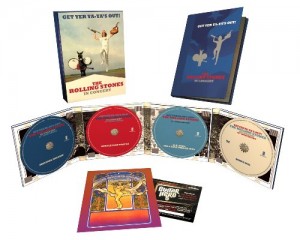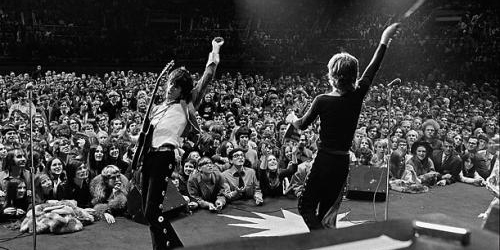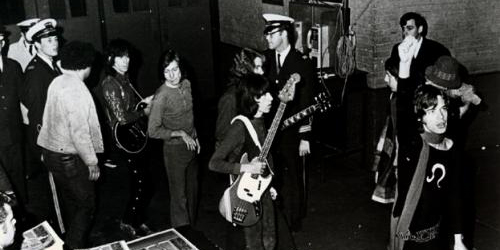There they go again.
I’ve got nothing. Full marks to any act that is able, much less willing, to strut around the stage after doing it on and off for half a century.
I like to tell the story about seeing them in 1989, fall of my sophomore year in college (I was 19; or put in a different context, more time has passed in my life since then). I told my semi-skeptical buddy “We have to go. What are the chances we’ll ever be able to see them again?”
Ha, ha, right?
But Living Colour was on the bill, and that was the extra incentive I needed. Also, this was the last days of an old-fashioned era when you could actually buy (or buy scalped) tickets without getting a second job. It was, in short, an era when a broke-ass college kid and his roommate could roll up to RFK Stadium with neither tickets nor a clue, and score, as expected.
The show itself? Eh. Of course, this is coming from a dude who thought the footage from the ’81 tour was lackluster. (There are a mere handful of rock acts who can still crush it, consistently, in a live setting after the age 40, and The Stones, for my money, are not in that category. That said, last night’s gig is getting mostly solid reviews, so good for everyone involved.)
It’s almost enough to make a younger lad forget the band once owned the joint when they strolled on stage. Almost.
As such, since they have neither burned out nor faded away, I’ll give the devils their due (but no sympathy) and as they continue to cackle and stagger all the way to the bank, the rest of us can remember the better days. (From the PopMatters review, 11/09, HERE.)
The Greatest Rock & Roll Band in The World: Liver Than They’ll Ever Be
Best live album ever?
Who cares. What is beyond dispute is that 1970’s Get Yer Ya-Ya’s Out is certainly the best live album the Rolling Stones ever recorded. And here we are, 40 years after the concerts took place in NYC at Madison Square Garden. World’s Greatest Band + World’s Greatest Stage = Deluxe Box Set! What are we looking at here? The original, remastered album? Check. Six unreleased tracks? Check. Bonus disc of opening acts B.B. King and Ike & Tina Turner? Check. Bonus DVD mixing live songs and offstage antics? Check. Obligatory booklet with critical essays and never-before seen photos? Check. Caveat emptor: for anyone thinking of shelling out $40-to-$60, be warned that the extra Stones material and the DVD are both less than 30 minutes in length. For Stones enthusiasts, this newly unearthed bounty is essential and price should be no object.
Let’s leave aside the sociopolitical implications of whether or not the ‘60s effectively ended at Altamont. The conventional shorthand analysis posits that the decade died the moment that unfortunate 18-year-old was stabbed to death by a member of Hell’s Angels while the band played on. Revisionist historians will always have a tough time selling the fact that Woodstock—an event only a few months old at this point—signaled the full flowering of Flower Power, and yet the Altamont tragedy slammed that door forever shut. The Stones, of course, did not make it to Woodstock (they were not, in fact, invited). And so there is more than a little symmetry here: the band some considered too incendiary to take part in the festival upstate went ahead and claimed New York City, then closed the book on the decade a week later in California. Or something.

Get Yer Ya-Ya’s Out! (and the subsequent Altamont concert, as well as the corresponding footage captured for posterity in the documentary Gimme Shelter) showcase the band stepping into the spotlight and becoming the undisputed alpha dogs of rock and roll. The Stones did more than fill the considerable void left by the dissolution of the Beatles; they were putting the finishing touches on a full-circle consummation of the British invasion—that musical and cultural phenomenon both these bands helped engineer. To appreciate how far the music had come in less than a decade, consider the formula for some of their earliest hit singles: ambitious, if tentative imitations of songs (most famous, some not) by Americans (some white, most not). More so than any other band (except possibly the Animals), the Rolling Stones were infatuated with American blues music. This is played out, in a literal sense, courtesy of the two distinctly uncommercial blues tunes they chose to perform. “Prodigal Son” (covered on Beggars Banquet and featured during this tour) and “You Gotta Move” (played on the tour and included on the subsequent Sticky Fingers) are respectful nods to their elders as well as confident statements of purpose. The band had found its voice, but was unafraid—and quite willing—to celebrate the milestones that made their music possible.
By the time Mick and the boys, who had taken to calling themselves—without a trace of irony—the greatest rock and roll band in the world, took the stage at MSG in November 1969, they were smack in the middle of that unprecedented (and possibly unrivaled) stretch of studio albums. On Beggars Banquet (1968) and Let It Bleed (1969) the band had convincingly incorporated certain elements of the blues idiom but, crucially, transmuted their influences and aspirations into potent material that blended danger and abandon. And attitude. No matter how hip John Lennon was, or how earnest Paul McCartney tried not to be, there was no question that those two cared; they wanted—and likely needed—approval (from the world; from each other, and the perceived lack thereof did more than anything else to split up the band). The Stones, on the other hand, presented the image that they could care less. Even if it was a calculated stance (and in fairness, we are talking about Mick Jagger, a man who never met a camera or mirror he did not court), it was convincing. And irresistible.
Having wallowed (quite purposefully) in the deep, dark blues on Beggars Banquet, the group lived the blues following the death of original member Brian Jones. That they were able to respond and deliver an album as rich and revelatory as Let It Bleed says more than a little about the resolve and focus the boys were radiating circa 1969. Indeed, the silver lining—artistically—in Jones’ departure (he was asked to leave the band shortly before his death) is the recruitment of guitarist Mick Taylor. If anything, Taylor augmented the band’s sound (this should not to be mistaken as a slight to Jones, whose contributions, at least through 1968, were considerable—but his drug use and personal problems had eventually made him a distraction who brought little to the table). All of a sudden, the band had a hungry, talented young guitarist who was quite comfortable playing blues and rock (indeed, he was recruited from John Mayall’s Bluesbreakers). This paid immediate dividends in the studio and significantly burnished the band’s live sound.

The music recorded for Ya-Ya’s traces the artistic path they’d been blazing, but it also anticipated the next two masterpieces: Sticky Fingers (1971) and, of course, Exile on Main Street (1972). With one foot in the past, represented by the band’s loving (and rollicking) covers of lesser-known Chuck Berry tunes, and one foot already in the next decade, evidenced by the nuanced renderings of recent and older original material, the Stones were an unstoppable force. They were also, like the Beatles before them, tinkering with the mechanics and possibilities of what rock music could be. Or, more to the point, what it needed to be in order to remain vital. The countrified vibe of “Let It Bleed” and “Country Honk” would continue to evolve on songs like “Wild Horses” and “Dead Flowers”. The urgent synthesis of old-school blues with raw-nerve rock demonstrated on “Gimme Shelter”, “Jigsaw Puzzle” and “Midnight Rambler” would further ripen on songs such as “Sway” and “Sister Morphine”.
So there they were, in November 1969, about to cement their status as the band. In a quintessentially New York City moment, the DVD shows pre-concert footage outside Madison Square Garden, where the billboard states: Today: the Rolling Stones. TOMW: Rangers. SUN: Knicks. Welcome to the Big Apple, baby. The camera catches the band exiting the limousine and they file into the arena one by one, a procession brought up from the rear by none other than Jimi Hendrix. It’s a moment that will make you do a double-take, and quickly rewind, as if to say “Was that really?” It is, really.
The set list is a solid representation of oldies (“I’m Free”, “Under My Thumb”) and cuts from the album their tour was promoting (“Live with Me”, “Love in Vain”) and recent singles (“Jumpin’ Jack Flash”, “Honky Tonk Women”). From the first notes of the first song, that heavier sound is in full effect: without an acoustic guitar softening the playful edges, “Jumpin’ Jack Flash”—grounded in Watts and Wyman’s wonderfully sludgy rhythm section—is dark and decidedly unflashy. Jagger, the consummate frontman, has the audience eating out of his palm immediately, as he playfully announces that he has busted a button on his trousers: “You don’t want my trousers to fall down now do ya?” After the obligatory squeal from the crowd, the band launches into Chuck Berry’s “Carol”. This version sounds more deliberate and dirty than their early single (one can hear the formulation of a sound that would be splattered all over Sticky Fingers), and the boys are fully locked in. Next is a dense (but not sloppy) reading of “Stray Cat Blues”, followed by a plaintive take on “Love In Vain”: the unvarnished agony of the originals is augmented by Richards and Taylor’s twin-guitar assault. (It’s difficult not to feel nostalgic here, appreciating the dutiful silence of the crowd: this is indeed a document from better days when people employed their ears and eyes and not their mouths at live shows.)
And then comes the centerpiece, which elevates these proceedings above and beyond even the best live albums by almost all other contenders. A snare drum roll and an electric guitar strummed as if being wound up, with a quick harmonica blast, and the singer’s opening salvo: I’m-a talkin’ bout the midnight rambler, everybody got to go… The version on Let It Bleed is an uncanny tour de force: it frightens, it stalks, and by the end, it exhausts. Against all probability, each of these elements are improved upon in this live take (and if, understandably, you are inclined to wonder how it’s even possible to improve upon the verb “stalk” or what on earth a verb is doing being invoked in the service of a rock song… just cue this one up, again). The Let It Bleed version is like a wrenching documentary about a serial killer; the live version is that psychopath kicking down your bedroom door. And more than that, this is what makes Mick—and the band—so inimitable: it is raunchy, it is spooky; it’s also sexy and intoxicating. Listen to those women (and men) in the crowd. When the band slows down the freight train (Wyman and Watts, again, are in very fine form), Mick’s muted, feral harmonica honks sound at once guttural and ecstatic, while his vocals blend braggadocio and intimidation. Some folks in the crowd think the song is over and begin applauding. Sit back down suckers. When Jagger toys with them, scoffing “Honey, it’s not one of those”, he is the crafty spider catching several thousand ecstatic flies. These nine minutes represent the closest any rock band came to sounding like Slim Harpo and Howlin’ Wolf. No other band could, and no other band ever tried.
Amusingly, a young lady toward the front, unconvinced, oblivious or ready for the coup de grace, asks for more. “Paint it black, you devil!” Right on cue, the band descends directly into the belly of the beast, firing up “Sympathy for the Devil”. Like “Midnight Rambler”, it is difficult to imagine this song being successfully rendered live. Unlike “Midnight Rambler”, this version does not surpass the original (how could it?) but it is a spirited and successful attempt. After an accelerated rendition of “Live with Me”, the group fires up its second Chuck Berry offering, a brilliantly measured deconstruction of “Little Queenie”. Once again, elements of the deceptively sloppy but confidently narcotic sound that permeated their next two albums are on delightful display: you can hear embryonic snatches of Sticky Fingers and Exile on Main Street throughout.
A faithful run-through of “Honky Tonk Women” is followed by a crisp, guitar-heavy rendering of “Street Fighting Man”. The bonus disc includes similarly professional interpretations of “Satisfaction”, “I’m Free” and “Under My Thumb” (the latter being an especially effective showcase for Jagger’s distinctly laconic vocals). The real gems are the two mid-set acoustic numbers, “Prodigal Son” and “You Gotta Move”. It’s nice to hear, but it’s incredible to watch (once again, these additions will be worth the price of admission for any Stones enthusiast). The DVD’s five tracks match the unreleased tracks on the CD, but the DVD has some hilarious footage of Mick cajoling the stoic Charlie Watts to sit astride a donkey in the freezing cold for a photo shoot. During the concert, both Jimi Hendrix and Janis Joplin can be seen (Joplin bopping behind stage and Hendrix rapping with Keith Richards in the dressing room). At the end, The Stones find themselves stuck on the tarmac with The Grateful Dead, waiting for their tardy plane. It’s awesome, but also somber to see these three deceased legends, two of whom would not survive the following year.
Finally, the real bonus must be the CD featuring B.B. King, followed by Ike & Tina Turner. In 1969, B.B. was already easing into elder statesman status and not quite the lean and mean machine featured on Live at the Regal (speaking of all-time great live albums). This is nevertheless a thoroughly enjoyable, if abbreviated set, and there is something genuine and beautiful about B.B. being on the bill at all. The Stones, like their British brethren, borrowed extensively from these blues gods; The Stones, perhaps more than any other band, went out of their way to pay tribute and share the love. The set from Ike & Tina is no slouch either, and it’s instructive to recall what a ball of fire Tina was back in the day. The band is real tight, offering supremely satisfactory versions of “Proud Mary”, “Son of a Preacher Man” and “Come Together”(!). But the highlight has to be Tina’s powerhouse performance of Otis Redding’s classic “I’ve Been Loving You Too Long”.
So, once again, the question of the day: best concert ever?
Well, taken in context—and considering the inclusion of both opening acts—it does not seem inappropriate to suggest that this represents as good a live performance as one could reasonably imagine. Put another way, wouldn’t you have given more than a little to have been there that night? Unless the possibility of time travel is perfected, this is the closest we’ll ever come.

